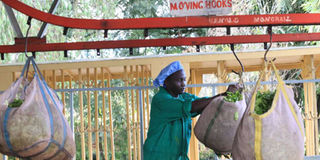Tea sector in dire need of good policies

A worker loads tea leaves onto a conveyor belt at Iriaini tea factory in Nyeri county/ Production of tea has gone down to 25 percent countrywide due to drought. PHOTO| JOSEPH KANYI | NATION MEDIA GROUP
What you need to know:
Considering agriculture is the mainstay of 70 per cent of Kenyans, it would be expected that resource allocation to the sector should be inspired by its contribution to economy
Kenyan tea has maintained its global platinum status for decades despite insubstantial investment in mechanisation and value addition.
In spite of having a dominant product that is self-marketing, tea farmers and the entire industry at large are yet to fully maximise on the abundant stipends to be derived from initiatives such as value addition and strengthening of the value chains.
Creating jobs and delivering a better life for all Kenyans was the theme of this year’s budget. And considering agriculture is the mainstay of 70 per cent of Kenyans, it would be expected that resource allocation to the sector should be inspired by its contribution to economy. Unfortunately, that is not the case.
It should not be lost that commercial crops sector has for decades been a major income earner for the country. For instance, Kenyan tea has maintained its global platinum status for decades despite insubstantial investment in mechanisation and value addition.
In spite of having a dominant product that is self-marketing, tea farmers and the entire industry at large are yet to fully maximise on the abundant stipends to be derived from initiatives such as value addition and strengthening of the value chains.
This, however, requires strategy and significant resource allocation. In the 2017/2018 budget, the government promises to focus on agro-processing industries that seek to brand tea, coffee, floriculture, horticulture, dairy and fruit products as well as textile.
In the Sh2.6 trillion budget, the government has allocated Sh4 billion for subsidised fertiliser and an additional Sh100 million for mechanisation.
It had been expected that in the 2017 budget, more funds would be availed towards research and development especially in the agriculture sector focusing on food security and other strategic commercial crops.
Last year, the budgetary allocation to agricultural related ministries stood at 7 per cent of total budget while the Ministry of Agriculture was allocated 2 per cent. The Maputo Declaration, which Kenya is a signatory, recommended countries to invest at least 10 per cent of their budgets to agriculture.
Partnership with government is very critical to thriving of the tea and agricultural sectors at large and government’s obligation should not be confined to infrastructure and relevant policy formulation.
Among the strategies mentioned in the budget proposal that should be of concern to tea stakeholders include supporting domestic production and value chains, boosting exports, encouraging entrepreneurship, and continuing with business climate reforms.
This is of paramount importance to tea producers, who are currently facing astronomical production overheads, aggravated by last year’s Employment Court ruling that directed the firms to increase the remuneration to workers.
The local tea industry continues to experience an enormous value chain imbalance and farmers are barely breaking even in spite of the centrality of the sector in contribution to the Gross Domestic Product.
Tea remains the leading foreign exchange earner contributing 25 per cent of total inflows, which accounts for 7 per cent of GDP and over five million people in rural Kenya have the crop to thank for their transformed social economic lives.
But while other tea producing countries like Sri Lanka that has a full Cabinet Minister responsible for tea continue to develop policies and marketing structures that ensure their product compete favourably in the global markets, the opposite is happening in Kenya.
The former Tea Board of Kenya was collapsed and reduced into a directorate under AFA, which has no representation of the industry stakeholders in the board. The former Tea Research Institute was also reorganised and lumped up in the new KALRO Act.
These two critical institutions ensured that there was a seamless link in aligning research and development, policy and legislative programmes of the tea crop all the way from the garden to the cup.
Policy makers need to create an enabling environment for the industry to regain its lost glory and secure the crop into the future.
The writer is the CEO of Kenya Tea Growers Association.


